HDR10+: the new HDR standard that's taking a leaf out of Dolby's book
Metadata for all

You've heard of HDR, but how does HDR10+ differ and, importantly, do you need it when you're buying a new TV?
HDR10+ is a video format that’s increasingly found on HDR televisions. HDR TVs might only be a few years old, but we already have a confusing handful of different HDR standards competing for prime of place on our TV displays.
First came HDR10, then Dolby Vision, and more recently Hybrid Log Gamma and Advanced HDR.
As if that all of those aren't already enough to wrap our heads around, there’s now another kind of TV tech: HDR10+. This video format will bring you the same advanced functionality you'd get from Dolby Vision but to an open standard, one that content makers can use without having to pay Dolby's hefty licensing fees.
Like Dolby's competing format, HDR10+ uses 'dynamic metadata' in order to enhance HDR images in each scene or shot. What this means is that viewers get the most out of every movie, documentary, or TV show.
HDR10+ might have 10-bit color compared to Dolby Vision's 12-bit, but this should at least make for a better balance between light and dark scenes.
We know what you’re thinking. Is HDR10+ more hyped up TV tech that'll be gone in a year? Probably not. The HDR standard has been packed into every Samsung 4K TV since 2017, not to mention many Panasonic TVs and Blu-ray discs from 20th Century FOX. What that means is the HDR10+ revolution may have already begun.
Get daily insight, inspiration and deals in your inbox
Sign up for breaking news, reviews, opinion, top tech deals, and more.
It’s also worth mentioning that HDR10+ Adaptive is also featured in many high-end TVs these days. This is a way to calibrate picture settings on HDR10+ content in response to the intensity of light in the room around your TV screen.
Check out our guide below, which helps to demystify HDR10+, HDR10+ Adaptive and explains why you need to know about this increasingly popular TV tech.
Check out the video below for everything you need to know about HDR.
Where did HDR10+ come from?
HDR10+ first came on the TV tech scene back in April 2017. This was when Samsung announced it was partnering with Amazon Prime Video to support the new format, but the format took a big step forward last August with the announcement that 20th Century Fox and Panasonic were joining forces with Samsung to develop the format further.
2018's CES saw the format come to physical media with the announcement that it had been been accepted as part of the Ultra HD Blu-ray specification. Panasonic then followed that announcement up by saying its new 2018 players will support the format, but there isn't any word on which discs will be available.
Then, in early March 2018, Samsung took the stage at its annual TV unveiling to once again reaffirm its commitment to the standard by putting it into every one of its 2018 QLED TVs.
Fast-forward a few years and in January 2020 Samsung announced that two significant new partners have signed on to HDR10+, including Vizio TVs and Google Play streaming. Widening the net for both TV makers and content distributers should make it easier for consumers to find HDR10+ content and play it back as well.
For more on the content side, you can already find around 100 movies and TV shows in HDR10+ on Amazon Video and Netflix has suggested it might support the format in the future, although it currently has no firm plans to do so.
Why do we need HDR10+?
But do we even need another standard of HDR in the first place?
The reasoning we've heard comes down to the creation of content. From how we've come to understand it, it's far easier for production houses to create HDR10+ content instead of Dolby Vision. Whereas the latter requires a scene-by-scene color correction, the former can take HDR10 content and bring it up to par without any extra labor.
It turns out that content creators really like that last part: Amazon already has a number of HDR10+ shows, including The Grand Tour, The Marvelous Mrs. Maisel and The Man in the High Castle, to name a few, and it's only a matter of time until the first HDR10+ UHD Blu-ray discs arrive on the market.
All things considered, the early signs for HDR10+ are looking positive. Panasonic has been bringing the technology to most of its high-end TVs since 2018 and it currently features in its flagship TV, the Panasonic JZ2000 4K OLED TV, in addition to many of Samsung's new TVs, presumably the entire 2021 QLED range.

What TVs come with HDR10+?
According to the official HDR10+ website, there are more than 700 models of TV, Blu-ray players, and mobile devices that are certified with the video format.
The brands on the list include Samsung, Toshiba, Oppo, TCL, Xiaomi, OnePlus, Panasonic, Hisense, Vivo.
A few of our favourite models with HDR10+ certification include:
Smartphones: Samsung Galaxy Fold, Samsung Galaxy Note, OnePlus 7 Pro, Xiaomi Mi 10
Blu-ray players: Panasonic DP-UB420, Panasonic DP-UB9000, Samsung UBD-M9500
Televisions: Samsung The Frame TV, Samsung Q70 QLED TV, Samsung NU8000, Hisense H55U7B, Panasonic GZ1500 4K OLED TV, Panasonic GZ950 / GZ1000 4K OLED, Hisense U8B ULED TV (But there are literally hundreds on the list that are HDR10+ friendly.)
HDR10+ Adaptive
We know we've only just demystified HDR10+, but there's another type you need to know about: HDR10+ Adaptive.
HDR10+ Adaptive is the answer to an age-old problem many of us have when it comes to light. Many of us (obviously) watch television outside of a dedicated, light-proof home cinema room. We put on our favorite Netflix shows in rooms not ideally equipped to keep out sunlight because we want to keep some visibility to eat, text, or cycle on an indoor bike while catching up on our programmes. If you're prone to daytime watching too, perfect viewing conditions aren't really an option.
That's where HDR10+ Adaptive comes in. It calibrates picture settings on HDR10+ content – that is, films or TV shows made in the dynamic HDR format favored by Samsung – in response to the intensity of light in the room around your TV screen.
New Samsung TVs will be better than ever at displaying HDR10+ content, it seems, after the world's largest TV maker announced a new feature to calibrate picture settings in response to ambient light.
Does HDR10+ spell the end for Dolby Vision?
That's unlikely.
Even if HDR10+ gains the same sort of traction, Dolby Vision still has the advantage of more advanced tech, with support for 12-bit color and up to 10,000 nits of brightness.
The lack of licensing fees with HDR10+ could end up being mightily tempting for manufacturers and content creators alike – but it's not like big Hollywood blockbusters are hurting when it comes to budget.
The most likely scenario that we can see happening is the peaceful coexistence of HDR10+ and Dolby Vision, a idea that Dolby's SVP of Consumer Entertainment Giles Baker seems to tolerate – if not directly support.
Whichever format wins or loses, the result is going to be better picture quality for all – and that's something we can all get behind.
Henry is a freelance technology journalist, and former News & Features Editor for TechRadar, where he specialized in home entertainment gadgets such as TVs, projectors, soundbars, and smart speakers. Other bylines include Edge, T3, iMore, GamesRadar, NBC News, Healthline, and The Times.
